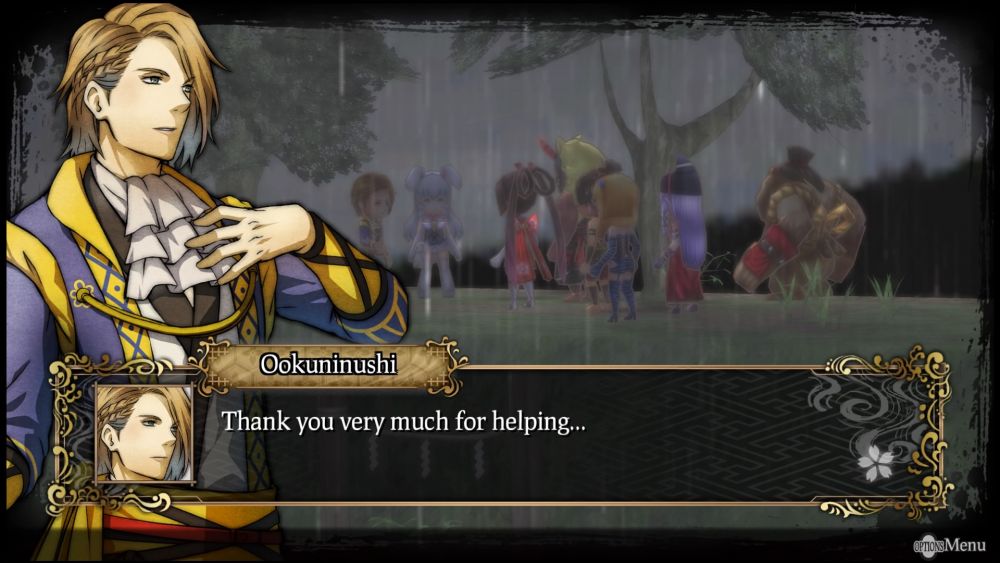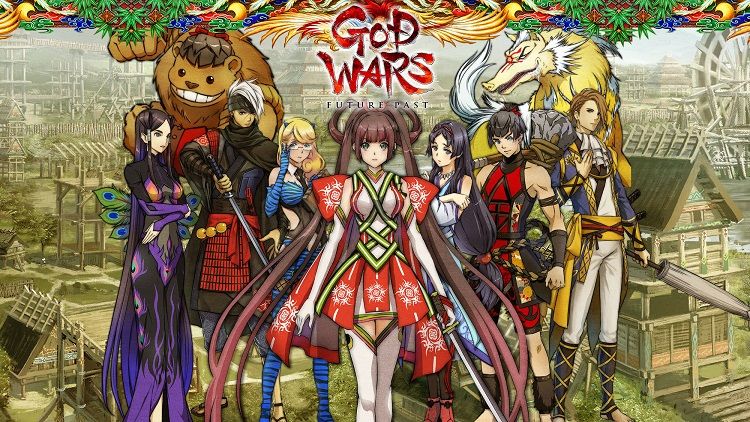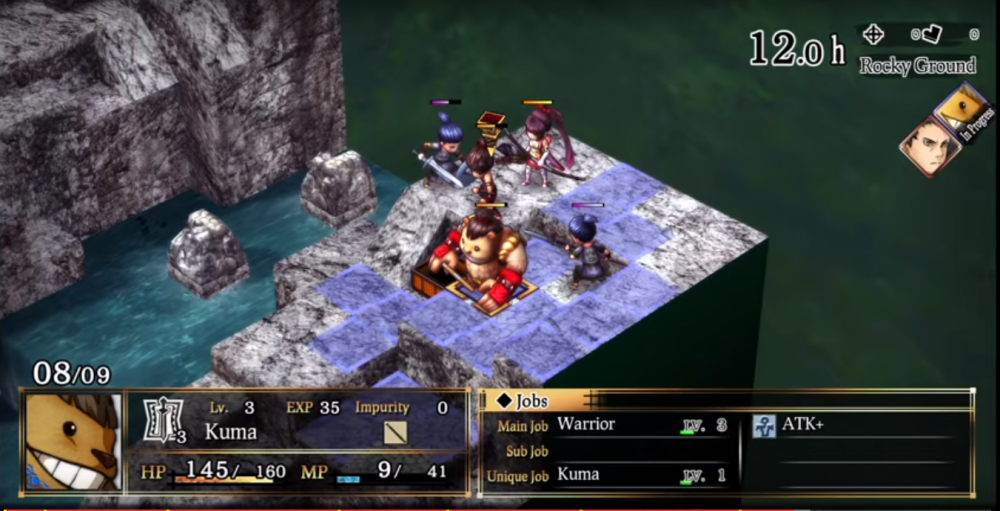God Wars: Future Past is a tactical, turn based role-playing game exclusive to the PlayStation 4 and PS Vita systems. It’s gameplay is enveloped inside of a powerful story about ancient Japan and takes players on an adventure throughout the land of Mizuho and its three nations.
Game Name: God Wars: Future Past
Platform: PlayStation 4 and PS Vita
Publisher: Kadokawa Corporation & Nippon Ichi Software
Developer: Kadokawa Corporation
Release Date: June 20, 2016
Price: PS4 $49.99, PS Vita $39.99
The gods are upset and have set rage upon the nation of Fuji. In order to calm the god’s and save her people, Queen Tsukuyomi decides that she must sacrifice her daughter, Sakuya, into the mouth of Mount Fuji’s volcano. Years pass and the gods have calmed, however, Sakuya’s sister, Kaguya, is locked away in a private shed to become the next sacrifice when needed. Thankfully, Kaguya’s childhood friend, Kintaro, and his sidekick, Kuma, come to her rescue to set her free. From that point, the game progresses with Kaguya, the princess of Fuji, as players go on a journey to alter her intended fate as she refuses to believe that sacrifice is the only way to please the gods.
God Wars: Future Past tells a beautiful and easy to follow story while engaging players with its strategic gameplay elements. The game immediately opens with a dramatic sequence of images and onomatopoeias similar to a manga or comic and afterward, flows into a short animated sequence, giving players more context for what is going on.
Besides that, players get the most interaction and learn about characters simply through the in-game dialogue. This is shown on screen with character images on one or both sides. I found this collection of cut scenes of to be such a refreshing way to tell the story and definitely enjoyed it!
This game is broken down into four chapters and several episodes in each. After episodes are completed players will go on to the map to progress with the story. This is where players are able to go to shops and buy new items and equipment and also edit their characters to change their jobs, skills, and gear. I would spend a lot of time here in order to prepare for the next battle.
As a rookie in the turn-based role-playing genres, I certainly had to ease my way into the gameplay in God Wars: Future Past and its mechanics. Allies and opponents move square by square along a gridded map. This means that characters have a limited number of spaces to move and the same goes for weapon use. The good thing is that certain powerful weapons can be used to attack opponents farther away rather than the restricting squares close by.
Again, this game took some time for me get used to, but after playing for a few hours, I began to compare the elements and play style to that of chess. The select grids reminded me of a chess board and the characters, each with different strengths and roles, made me think of the various pieces used throughout a chess game. Patience is also key, as I quickly learned to assess the situation at hand and make the best play possible without being in such a rush.
Regardless a decision must be made, whether the choice leads a direct attack, sending a healing prayer to a hurt friend, or choosing to standby rather than move along the grid. Though I’m not the best chess player, I did realize that making wise decisions and thinking ahead of your turns were essential for success in battles.
As cliché as it sounds, God Wars: Future Past is a perfect example of the saying, “teamwork makes the dream work”. This game is not played with any single player at a time, rather, a group, a team, or shall I say an army of friends fighting to assist Kaguya on her journey against any and all threats. Different roles such as striker, defender, and healer play extremely important parts throughout a battle.
At times I would feel overwhelmed while controlling seven characters on the grid, and something great about this game is that there is an AI feature built in to assist you in gameplay. More often than not, I would have at least two or three characters assigned to specific roles, such as healer and support, that way I could continue through the battle as striker and defender with top-notch assistance.
Though there were many moments of frustration with this game in the beginning, I began to get the hang of things and the game mechanics after a while. However, this did not mean that the ride was smooth. For example, I would get the most upset when striking an opponent and then missing, resulting in zero damage. On top of that, having an opponent on their last bit of health suddenly healed by their teammate felt like a slap in the face at times. Thankfully, finding ways around simply took practice.
As the game progressed Kaguya and her friends become stronger, but so do the enemies! Players can easily become stronger by acquiring and improving skills when leveling up along the skill tree. It is simply a fact that battles last a long time, which in turn made things a bit boring to me after a while, especially when battle conditions would call for you to defeat all 12 (or more) of the enemies.

Controls in this game were simple to say the least. No need for use of the left analog stick as you will be controlling different characters and choosing your next action by using the directional pad. The right analog stick however is used to rotate the camera to view all angles of the map. Rather than specific buttons on the Dualshock corresponding to special attacks, just about everything you do is chosen within a menu using the select button.
The graphics in God Wars: Future Past reminded me of what I would see on a handheld console, which this game is also available on (PS Vita). Other than the exciting cut scenes, the 3D graphics and map layouts were crisp on the PlayStation 4, but nothing spectacular. As far as sound, players can always tell when trouble is coming by the sudden switch in music. A peaceful, yet heroic theme song would play often throughout gameplay until the intensity of music heightened, giving players a sense of urgency and concern for the safety of their team.
I enjoyed God Wars: Future Past for what it was. A strategic, turn-based, role-playing game with challenging enemies, bosses, and customizable character traits. Though the game felt a bit boring due to its repetitive nature and long fights, the story was enough for me to get through to find out the outcome. Extra hours can be put into the game by the player going back to the shrine, a special area located on the map to pick up requests for extra battles. These battles take place on cleared stages and when going back, players will notice new objectives and enemies to defeat in previous areas. Playing this game on the PlayStation 4 was nice for seeing this in a larger perspective via my television, but at times felt that I would have had more fun with this game on the go using the PS Vita, where I could fill in time on a trip or waiting room.
*God Wars: Future Past was provided to us by Kadokawa Corporation for review purposes. For more information on how we review video games and other media/technology, please go review our Review Guideline/Scoring Policy for more info.
Summary
Verdict
God Wars: Future Past is an excellent turn based RPG for fans of the genre. Players will certainly enjoy the story telling through cutscenes and lively cast characters met along the way. And even though battles can become challenging at times, coming back with a new strategy in mind almost always leads to victory. PS Vita owners would definitely get the most out of this game with its handheld version.
Pros
- Excellent story with fun and developing characters
- Wide range of weapons and abilities
- Helpful AI
Cons
- Slow paced
- Long battles can become boring
- Would play better on a handheld console (PS Vita)
-
Witty sentence here and the score. remember to use the star system!




